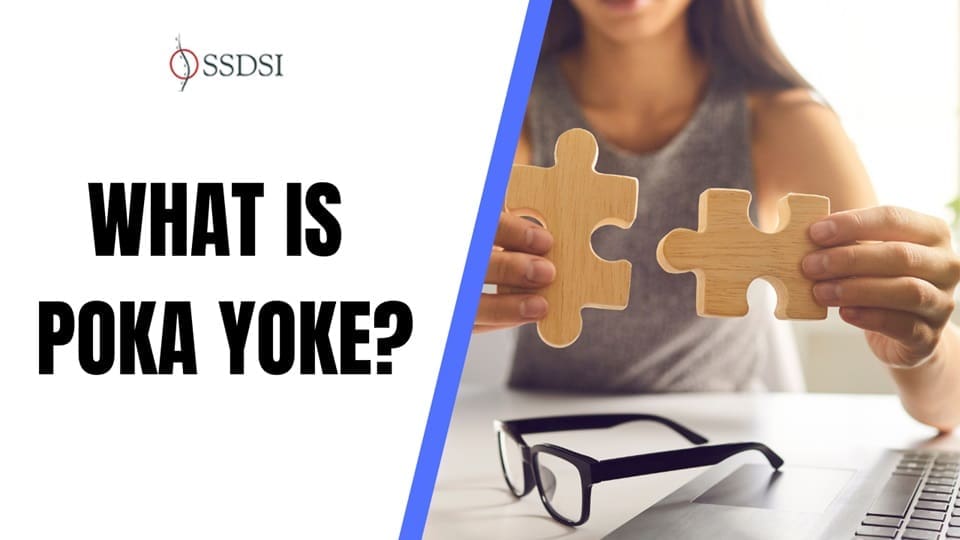Poka Yoke is a Japanese term that means “mistake-proofing.” It refers to mechanisms used in lean manufacturing processes to help prevent mistakes from occurring, thus ensuring high-quality production and reducing defects. Introduced by Shigeo Shingo in the 1960s as part of the Toyota Production System, this method has become an integral tool in modern manufacturing.
The goal of Poka Yoke is to eliminate errors, not just detect them. Shingo’s approach originally called “baka-yoke” (fool-proofing) was later changed to the more neutral term “poka-yoke” to avoid negative connotations.
Table of contents
What is Poka-Yoke?
The term Poka-Yoke comes from the Japanese words “poka” (inadvertent errors) and “yokeru” (to avoid), translating to “avoiding inadvertent errors.” The philosophy behind Poka-Yoke is centred on designing processes that prevent defects from occurring by ensuring the correct conditions are in place before a process step is executed. When prevention is not possible, Poka-Yoke detects errors early, minimizing their impact.
Initially used in Lean manufacturing, it is widely applicable across various industries. Its core objective is to achieve zero defects by preventing mistakes before they happen, making it a vital tool for improving efficiency and quality.
Core Purpose
The primary aim is to achieve zero defects by eliminating human errors. It was first introduced by Shigeo Shingo in 1961 at Toyota Motor Corporation under the name Baka-Yoke (fool-proofing). However, this term was later softened to Poka-Yoke (mistake-proofing) to avoid offending workers.
It is a key component of Shingo’s Zero Quality Control system, which aims to reduce the need for quality inspections by preventing defects from occurring in the first place. By using fail-safe mechanisms, it ensures that the correct part is used correctly, thus eliminating the possibility of error.
Key Principles
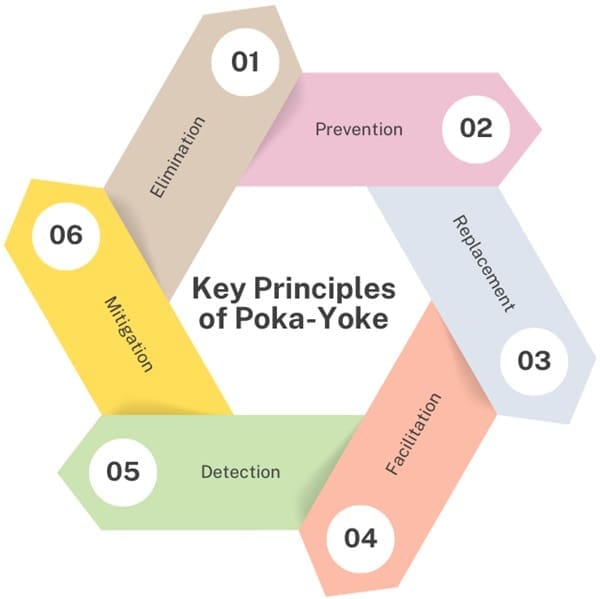
It follows six core principles to prevent and detect errors:
- Elimination: Remove the possibility of an error by redesigning the product or process so that the task or part is no longer necessary.
- Prevention: Design the product or process in a way that makes it impossible to make a mistake.
- Replacement: Substitute unreliable processes with more consistent, reliable alternatives.
- Facilitation: Simplify tasks by combining steps, making work easier and reducing the chance of error.
- Detection: Identify errors as they occur, allowing for immediate correction before further processing.
- Mitigation: Minimize the impact of errors if they do occur by ensuring they do not escalate into larger issues.
Types of Errors in Manufacturing
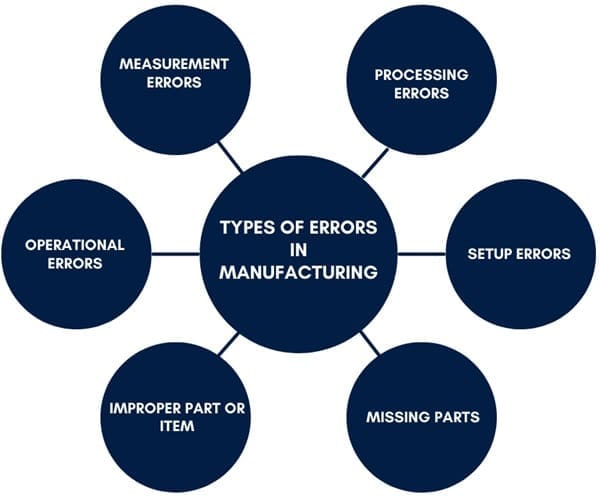
In general manufacturing, errors can manifest in various forms, including:
- Processing Errors: These occur when a process operation is missed or not performed as per the standard operating procedure.
- Setup Errors: When the wrong tooling is used or machine adjustments are set incorrectly.
- Missing Parts: This error occurs when not all parts are included in the assembly or production process.
- Improper Part or Item: Using the wrong part in the process leads to improper results.
- Operational Errors: Carrying out an operation incorrectly or following an incorrect specification version.
- Measurement Errors: These errors involve inaccurate machine adjustments, test measurements, or part dimensions from suppliers.
Implementing Poka-Yoke Techniques

It can be implemented through three main techniques: physical, operational, and philosophical approaches.
- Physical Techniques: Involve installing fixtures, sensors, or other components to prevent errors from occurring.
- Operational Techniques: Focus on modifying processes or using devices that reinforce correct procedures.
- Philosophical Techniques: Identify situations where defects are likely to occur and address them systematically.
Why Mistake-Proofing Is Needed?
In any production system, mistakes lead to defects that compromise product quality. Mistake-proofing is necessary to address issues before they become expensive problems. One of the objectives of lean manufacturing is to reduce scrap and avoid unnecessary rework.
By identifying the root causes of errors and addressing them early, companies can produce defect-free products, increasing customer satisfaction and reducing costs associated with faulty products.
For example, in a barrier audit process used in many industries, poka-yoke solutions can be implemented to eradicate human error at the final inspection stage, preventing defective products from reaching the customer.
Methodology and Types of Poka Yoke
Poka Yoke is implemented through two main methodologies: prevention-based and detection-based poka-yokes.
- Prevention-Based: These mechanisms sense potential errors before they occur. The goal is to stop the process or alert the operator when something goes wrong. There are two approaches to prevention-based systems:
- Control Method: This method halts the production process when an error is detected, allowing corrective action to be taken immediately to prevent defective products from being produced.
- Warning Method: This approach involves signalling the presence of an abnormality, such as through alarms or visual indicators like lights or buzzers. The operator can then take corrective measures before the error leads to defects.
- Detection-Based: While prevention is ideal, there are situations where defects cannot be entirely prevented. In these cases, detection-based poka yokes help identify defects before they reach the customer. There are three main types of detection-based systems:
- Contact Method: This system detects deviations in shape, size, or other physical characteristics by maintaining direct contact with the product. For example, sensors might detect if a part is missing or incorrectly sized.
- Fixed-Value Method: This approach ensures that a specific number of steps or actions are completed. It uses counters, sensors, or other devices to ensure each step in the process is followed correctly, such as ensuring the correct number of screws are inserted.
- Motion-Step Method: This ensures that operators complete each necessary step in the production process without performing steps out of order or missing any. A common example is the use of colour-coding to prevent mix-ups with parts.
How does Poka Yoke work?
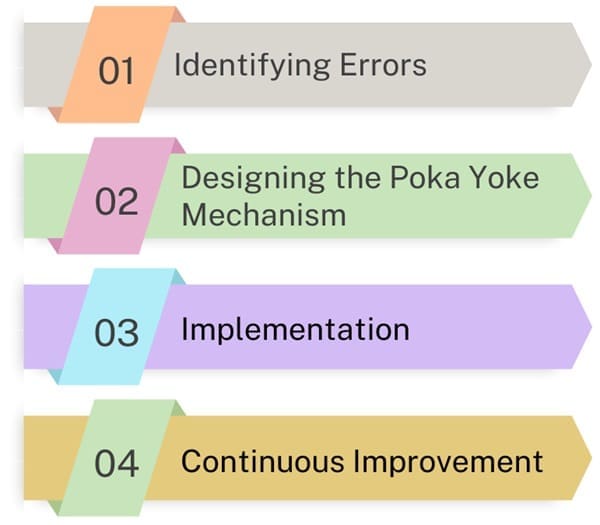
The implementation of poka-yoke typically follows a structured approach:
- Identifying Errors: The first step is recognizing where errors commonly occur within a process. Companies must analyze past defects and understand the root causes behind these issues.
- Designing the Poka Yoke Mechanism: Once errors are identified, a system must be designed to either prevent the error or alert the operator when something goes wrong. For instance, in a case where workers forget to insert a component, a poka-yoke mechanism might require the worker to prepare the components in a placeholder first. If a component is left behind, it signals that a step was missed.
- Implementation: The poka-yoke mechanism is then integrated into the process. This could involve adding sensors, alarms, or stop mechanisms to ensure that errors are caught and corrected immediately.
- Continuous Improvement: Once implemented, poka-yoke systems must be continually evaluated and improved to ensure they remain effective.
Case Study: Application in Manufacturing
A real-world example of poka-yoke in action can be seen in a small air duct manufacturing company. In this company, excess material must be manually removed after the blow molding process, which often leads to defects due to worker error.
By implementing a poka-yoke system, the company reduced the likelihood of improper material removal and minimized product rejections, saving both time and money.
The solution involved training workers to identify potential errors and integrating tools that would stop the process if material was improperly removed. This not only improved product quality but also boosted worker efficiency.
Challenges and Considerations
While poka-yoke is highly effective, it’s not without challenges. Companies must invest in designing and implementing error-proofing mechanisms, and in some cases, the cost of these systems might outweigh the cost of the defects they prevent.
Additionally, not all processes can be entirely error-proofed—there will always be some margin for human error. However, the goal is to minimize this margin as much as possible.
Furthermore, a culture of continuous improvement is essential for successful poka-yoke implementation. Employees must be trained to recognize potential errors and be encouraged to suggest improvements to the poka-yoke systems in place. A proactive approach to mistake-proofing can lead to better outcomes across the organization.
Implementation of Poka-Yoke
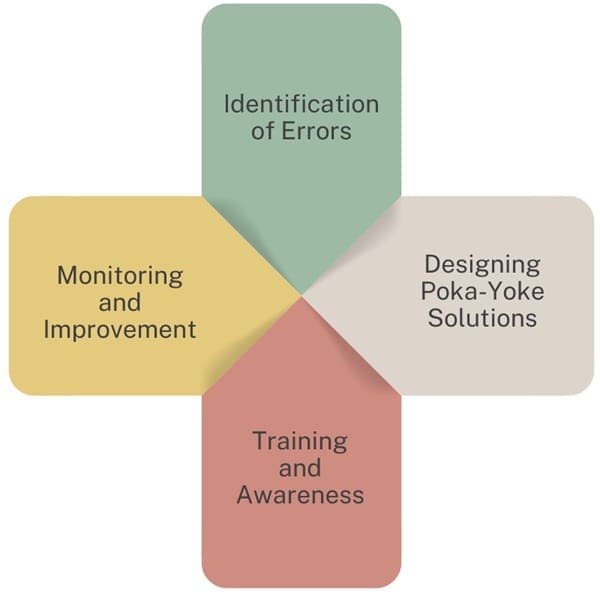
Implementing Poka-Yoke in any organization involves several key steps:
- Identification of Errors: The first step is to identify where errors are likely to occur in the process. This is often done during the design phase using tools like Failure Mode Effects Analysis (FMEA).
- Designing Poka-Yoke Solutions: Once potential errors are identified, appropriate Poka-Yoke mechanisms are designed and implemented to prevent or detect those errors.
- Training and Awareness: Workers must be trained to understand how the Poka-Yoke mechanisms work and why they are important. This ensures that the system is used correctly and consistently.
- Monitoring and Improvement: Poka-Yoke systems should be regularly monitored to ensure they are functioning as intended. Continuous improvement processes should be in place to enhance the effectiveness of these systems over time.
Objectives of Poka Yoke Implementation
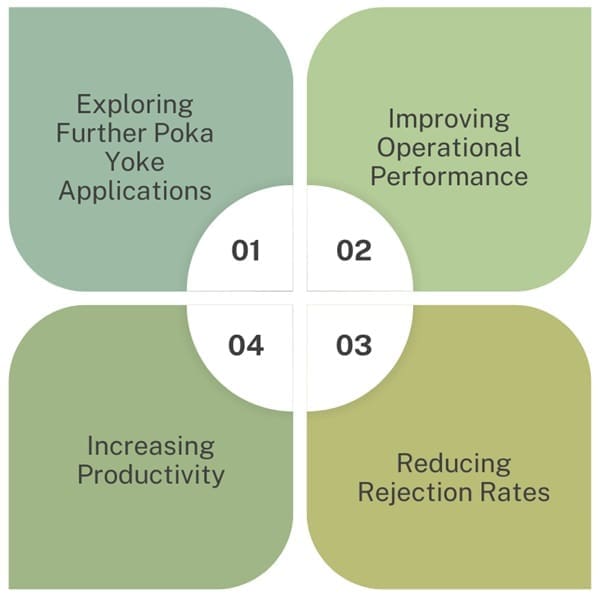
Poka Yoke’s effectiveness can be measured through several objectives:
- Improving Operational Performance: Implementing poka-yoke in an assembly line can reduce the likelihood of errors, enhancing overall efficiency. When fewer mistakes are made, the entire production process flows more smoothly.
- Reducing Rejection Rates: Defects lead to wasted materials, time, and money. By preventing mistakes, companies can significantly reduce the number of rejected products, thus lowering costs and enhancing profitability.
- Increasing Productivity: Error prevention boosts productivity by ensuring that workers spend less time reworking defective products and more time producing quality items.
- Exploring Further Poka Yoke Applications: Beyond the assembly line, poka-yoke principles can be applied to various processes within a company, including quality assurance and operational management.
Final Thoughts
Poka-Yoke is a powerful tool for improving productivity and quality in any industry. By preventing or detecting errors early in the process, Poka-Yoke helps organizations reduce waste, improve efficiency, and achieve zero defects.
While it was originally developed for Lean manufacturing, its principles are applicable across a wide range of industries and processes, making it a versatile and effective solution for improving operational performance.

About Six Sigma Development Solutions, Inc.
Six Sigma Development Solutions, Inc. offers onsite, public, and virtual Lean Six Sigma certification training. We are an Accredited Training Organization by the IASSC (International Association of Six Sigma Certification). We offer Lean Six Sigma Green Belt, Black Belt, and Yellow Belt, as well as LEAN certifications.
Book a Call and Let us know how we can help meet your training needs.

